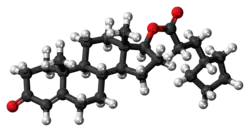Testosterone cypionate
 | |
 | |
| Clinical data | |
|---|---|
| Trade names | Depo-Testosterone, others |
| Other names | TC; TCPP; Testosterone cipionate; Testosterone cyclopentylpropionate; Testosterone cyclopentanepropionate; Testosterone 17β-cyclopentylpropionate |
| Routes of administration | Intramuscular injection |
| Drug class | Androgen; Anabolic steroid; Androgen ester |
| Legal status | |
| Legal status |
|
| Pharmacokinetic data | |
| Bioavailability | Oral: very low Intramuscular: very high |
| Metabolism | Liver |
| Elimination half-life | ~8 days i.m.)[1] |
| Excretion | 90% Urine; 6% feces[1] |
| Identifiers | |
IUPAC name
| |
| CAS Number | |
| PubChem CID | |
| DrugBank | |
| ChemSpider | |
| UNII | |
| KEGG | |
| ChEMBL | |
| ECHA InfoCard | 100.000.335 |
| Chemical and physical data | |
| Formula | C27H40O3 |
| Molar mass | 412.614 g·mol−1 |
| 3D model (JSmol) | |
SMILES
| |
InChI
| |
Testosterone cypionate, sold under the brand name Depo-Testosterone among others, is an androgen and anabolic steroid (AAS) medication which is used mainly in the treatment of low testosterone levels in men.[2][3][4] It is also used in hormone therapy for transgender men.[5][6] It is given by injection into muscle or subcutaneously, once every one to four weeks, depending on clinical indication.[4][7][8][9]
Side effects of testosterone cypionate include symptoms of masculinization like acne, increased hair growth, voice changes, and increased sexual desire.[4] The drug is a synthetic androgen and anabolic steroid and hence is an agonist of the androgen receptor (AR), the biological target of androgens like testosterone and dihydrotestosterone (DHT).[10][4] It has strong androgenic effects and moderate anabolic effects, which make it useful for producing masculinization and suitable for androgen replacement therapy.[4] Testosterone cypionate is a testosterone ester and a long-lasting prodrug of testosterone in the body.[7][2][3] Because of this, it is considered to be a natural and bioidentical form of testosterone.[11]
Testosterone cypionate was introduced for medical use in 1951.[12][13] Along with testosterone enanthate, testosterone undecanoate, and testosterone propionate, it is one of the most commonly used testosterone esters.[10][4] It is used mainly in the United States.[4] In addition to its medical use, testosterone cypionate is used to improve physique and performance.[4] The drug is a controlled substance in many countries and so non-medical use is generally illicit.[4]
Medical uses
Testosterone cypionate is used primarily in androgen replacement therapy.[14] It is currently FDA approved for the treatment of primary or hypogonadotropic hypogonadism (either congenital or acquired). Its safety in andropause (late-onset hypogonadism in men) has not yet been established.[1] It is currently used off-label for breast cancer, breast disorders, delayed puberty in boys, oligospermia (low sperm count), hormone replacement therapy in transgender men,[9] and osteoporosis.[15][1]
Side effects
Side effects of testosterone cypionate include virilization among others.[4] It can also create conditions for heart attack, enlargement of prostate gland, liver malfunction, issues related to coagulation, pulmonary embolism, and polycythemia.[16]
Pharmacology
Pharmacodynamics
| Medication | Ratioa |
|---|---|
| Testosterone | ~1:1 |
| Androstanolone (DHT) | ~1:1 |
| Methyltestosterone | ~1:1 |
| Methandriol | ~1:1 |
| Fluoxymesterone | 1:1–1:15 |
| Metandienone | 1:1–1:8 |
| Drostanolone | 1:3–1:4 |
| Metenolone | 1:2–1:30 |
| Oxymetholone | 1:2–1:9 |
| Oxandrolone | 1:3–1:13 |
| Stanozolol | 1:1–1:30 |
| Nandrolone | 1:3–1:16 |
| Ethylestrenol | 1:2–1:19 |
| Norethandrolone | 1:1–1:20 |
| Notes: In rodents. Footnotes: a = Ratio of androgenic to anabolic activity. Sources: See template. | |
Testosterone cypionate is a prodrug of testosterone and is an androgen and anabolic–androgenic steroid (AAS). That is, it is an agonist of the androgen receptor (AR).
Pharmacokinetics
The pharmacokinetics of testosterone cypionate via depot intramuscular injection, including its elimination half-life and duration of action, are said to be extremely comparable to and hence essentially the same as those of testosterone enanthate.[4][3] As such, testosterone cypionate and testosterone enanthate are considered to be "functionally interchangeable" as medications.[4] For reference, testosterone enanthate has an elimination half-life of 4.5 days and a mean residence time of 8.5 days and requires frequent administration of approximately once per week.[17] Large fluctuations in testosterone levels result with it, with levels initially being elevated and supraphysiological.[17] The pharmacokinetics of testosterone cypionate have been studied and reported.[18]
Chemistry
Testosterone cypionate, or testosterone 17β-cyclopentylpropionate, is a synthetic androstane steroid and a derivative of testosterone.[19][20] It is an androgen ester; specifically, it is the C17β cyclopentylpropionate (cypionate) ester of testosterone.[19][20]
History
Testosterone cypionate was first synthesized in 1951[21] and was introduced for medical use in the United States the same year under the brand name Depo-Testosterone.[12][13]
Society and culture
Generic names
Testosterone cypionate is the generic name of the drug and its USP.[19][20][22][23] The drug does not have an INN, USAN, or BAN.[19][20][22][23] It has also been referred to as testosterone cipionate, as well as testosterone cyclopentylpropionate or testosterone cyclopentanepropionate.[19][20][22][23]
Brand names
Testosterone cypionate is or has been marketed under a variety of brand names, including:[19][20][22][23]
- Andro Cyp
- Andronaq LA
- Andronate
- Dep Andro
- Dep Test
- Deposteron
- Depostomead
- Depotest
- Depo-Testosterone
- Depovirin
- Durandro
- Duratest
- Jectatest
- Malogen CYP
- Pertestis
- Testa-C
- Testadiate Depo
- Testex Elmu Prolongatum
- Testoject LA
- Virilon
Availability
Testosterone cypionate is marketed in the United States.[4][20] It is not widely available outside of the United States, though it has been marketed in Canada, Australia, Spain, Brazil, and South Africa.[4][20]
Legal status
Testosterone cypionate, along with other AAS, is a schedule III controlled substance in the United States under the Controlled Substances Act and a schedule IV controlled substance in Canada under the Controlled Drugs and Substances Act.[24][25]
References
- 1 2 3 4 Pfizer. "Depo-Testosterone; testosterone cypionate injection, USP" (PDF). U.S. Food and Drug Administration.
{{cite web}}: CS1 maint: uses authors parameter (link) - 1 2 Nieschlag E, Behre HM, Nieschlag S (26 July 2012). Testosterone: Action, Deficiency, Substitution. Cambridge University Press. pp. 315–. ISBN 978-1-107-01290-5.
- 1 2 3 Nieschlag E, Behre HM, Nieschlag S (13 January 2010). Andrology: Male Reproductive Health and Dysfunction. Springer Science & Business Media. pp. 442–. ISBN 978-3-540-78355-8.
- 1 2 3 4 5 6 7 8 9 10 11 12 13 14 William Llewellyn (2011). Anabolics. Molecular Nutrition Llc. pp. 212–216. ISBN 978-0-9828280-1-4.
- ↑ Costa, Laura Bregieiro Fernandes; Rosa-e-Silva, Ana Carolina Japur de Sá; Medeiros, Sebastião Freitas de; Nacul, Andrea Prestes; Carvalho, Bruno Ramalho de; Benetti-Pinto, Cristina Laguna; Yela, Daniela Angerame; Maciel, Gustavo Arantes Rosa; Soares Júnior, José Maria; Maranhão, Técia Maria de Oliveira (May 2018). "Recommendations for the Use of Testosterone in Male Transgender*". Revista Brasileira de Ginecologia e Obstetrícia. 40 (5): 275–280. doi:10.1055/s-0038-1657788. ISSN 0100-7203. PMID 29913543.
- ↑ Irwig MS (April 2017). "Testosterone therapy for transgender men". The Lancet. Diabetes & Endocrinology. 5 (4): 301–311. doi:10.1016/S2213-8587(16)00036-X. PMID 27084565.
- 1 2 Becker KL (2001). Principles and Practice of Endocrinology and Metabolism. Lippincott Williams & Wilkins. pp. 1185, 1187. ISBN 978-0-7817-1750-2.
- ↑ Ayd FJ (2000). Lexicon of Psychiatry, Neurology, and the Neurosciences. Lippincott Williams & Wilkins. pp. 974–. ISBN 978-0-7817-2468-5.
- 1 2 Hembree WC, Cohen-Kettenis PT, Gooren L, Hannema SE, Meyer WJ, Murad MH, et al. (November 2017). "Endocrine Treatment of Gender-Dysphoric/Gender-Incongruent Persons: An Endocrine Society Clinical Practice Guideline". The Journal of Clinical Endocrinology and Metabolism. 102 (11): 3869–3903. doi:10.1210/jc.2017-01658. PMID 28945902.
- 1 2 Kicman AT (June 2008). "Pharmacology of anabolic steroids". British Journal of Pharmacology. 154 (3): 502–21. doi:10.1038/bjp.2008.165. PMC 2439524. PMID 18500378.
- ↑ Santoro N, Braunstein GD, Butts CL, Martin KA, McDermott M, Pinkerton JV (April 2016). "Compounded Bioidentical Hormones in Endocrinology Practice: An Endocrine Society Scientific Statement". The Journal of Clinical Endocrinology and Metabolism. 101 (4): 1318–43. doi:10.1210/jc.2016-1271. PMID 27032319.
- 1 2 William Andrew Publishing (22 October 2013). Pharmaceutical Manufacturing Encyclopedia, 3rd Edition. Elsevier. pp. 3170–. ISBN 978-0-8155-1856-3.
- 1 2 Hoberman J (21 February 2005). Testosterone Dreams: Rejuvenation, Aphrodisia, Doping. University of California Press. pp. 134–. ISBN 978-0-520-93978-3.
- ↑ HRTGuru corp. "What is Testosterone Cypionate".
{{cite web}}: CS1 maint: uses authors parameter (link) - ↑ "Testosterone cypionate drug profile". Adis Insight.
- ↑ "Testosterone Cypionate Common Side Effects Reported by Real Users". Retrieved 2020-09-06.
- 1 2 Payne AH, Hardy MP (28 October 2007). The Leydig Cell in Health and Disease. Springer Science & Business Media. pp. 423–. ISBN 978-1-59745-453-7.
- ↑ Nankin HR (June 1987). "Hormone kinetics after intramuscular testosterone cypionate". Fertility and Sterility. 47 (6): 1004–9. doi:10.1016/S0015-0282(16)59237-1. PMID 3595893.
- 1 2 3 4 5 6 Elks J (14 November 2014). The Dictionary of Drugs: Chemical Data: Chemical Data, Structures and Bibliographies. Springer. pp. 641–642. ISBN 978-1-4757-2085-3.
- 1 2 3 4 5 6 7 8 Index Nominum 2000: International Drug Directory. Taylor & Francis. January 2000. pp. 1002–1004. ISBN 978-3-88763-075-1.
- ↑ Dekansi J, Chapman RN (September 1953). "Testosterone phenyl propionate (TPP): biological trials with a new androgen". Br J Pharmacol Chemother. 8 (3): 271–7. doi:10.1111/j.1476-5381.1953.tb00793.x. PMC 1509286. PMID 13093945.
- 1 2 3 4 Morton I, Hall JM (6 December 2012). Concise Dictionary of Pharmacological Agents: Properties and Synonyms. Springer Science & Business Media. ISBN 978-94-011-4439-1.
- 1 2 3 4 "Testosterone". Drugs.com International.
- ↑ Karch SB (21 December 2006). Drug Abuse Handbook, Second Edition. CRC Press. pp. 30–. ISBN 978-1-4200-0346-8.
- ↑ Lilley LL, Snyder JS, Collins SR (5 August 2016). Pharmacology for Canadian Health Care Practice. Elsevier Health Sciences. pp. 50–. ISBN 978-1-77172-066-3.